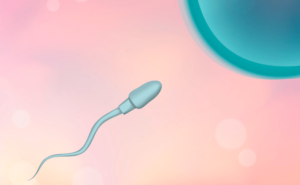Observation of Early Pregnancy (Weeks 2-3)
The number of weeks of pregnancy is counted from the start of the last menstrual period as 0 week 0 day of pregnancy. Note that ‘very early pregnancy’ is not a medical term, but refers to the period before implantation of the fertilised egg in the endometrium.
The first week is not exactly pregnancy and is the most fertile period. Around the second week, the egg and sperm combine at the end of the fallopian tubes, known as the fallopian ganglion, to form a fertilised egg.
The fertilised egg, which will later become a baby, passes through the fallopian tubes, dividing cells at a rate of once a day, and takes about a week to reach the uterus. Pregnancy is established when the fertilised egg implants in the endometrium at around the third week. The size of the baby at this time is still only about 1 mm.
Although it varies from person to person, bleeding may continue for about 1-2 days when the fertilised egg implants in the endometrium. This is called ‘implantation bleeding’ and is difficult to distinguish from menstruation, so those wishing to conceive should take care to check the date of the last menstrual period.
Growth Progress of Fetus in Early Pregnancy (Up to 13 Weeks 6 Days)
The baby is still small in early pregnancy. However, important organs such as organs and nerves are formed during this gestational week. NIPT is also available from 10 weeks 0 days of pregnancy to check the baby’s possible positive risk for chromosomal abnormalities and congenital diseases.
Growth of Fetus (Embryo) at 2 Months of Pregnancy (Weeks 4-7)
At around 4 weeks’ gestation, the foetus can be seen on ultrasound examination. During this period, when the baby’s body structure is still immature, it is not exactly called a ‘foetus’ yet. The baby inside the foetal sac is called the ’embryo’ until around 8 weeks’ gestation.
At five weeks’ gestation, the organs that form the basis of the organs and the umbilical cord are formed. The heart is also formed and blood is pumped to the baby’s body organs. By the time you are six weeks pregnant, you will be able to see the baby’s heartbeat during an ultrasound scan.
Size of Fetus at 7 Weeks of Pregnancy
Approx. 1 cm in height and 4 g in weight (about 1 cherry)
Growth of Fetus at 3 Months of Pregnancy (Weeks 8-11)
In the third month of pregnancy, the boundary between the head and torso, limbs such as arms and legs, and facial parts become clear and human-like. It is also around this time that nerve cells in the brain begin to form. As the weeks progress, the fingers and toes separate, the mouth and teeth are formed, and the reproductive organs are formed. By the 11th week of pregnancy, the baby is becoming more and more human, with eyelids, ears and lips also forming.
The risk of early miscarriage generally decreases after this number of weeks. After 10 weeks and 0 days of pregnancy, the NIPT test can be performed. If you want to know the health of your foetus at an early stage of pregnancy, consult a NIPT facility or medical institution about NIPT.
Size of Fetus at 11 Weeks of Pregnancy
Height about 4 cm, weight about 30 g (about 1 strawberry)

Growth of Fetus at 4 Months of Pregnancy (Weeks 12-15)
When the pregnancy reaches 12 weeks, the baby enters the stable phase and many pregnant women find that morning sickness symptoms subside.
The foetus has completed its fingers and begins to practise breathing and drinking breast milk while drinking and spitting up amniotic fluid.
Most of the body’s organs are formed at around 14 weeks’ gestation, after which the skin thickens and muscles are gradually developed. The 15th week is also the gestational week when the placenta (foetal plateau) is completed.
Size of Fetus at 15 Weeks of Pregnancy
Approx. 16 cm tall, weighing about 100 g (about 1 lemon)
Growth Progress of Fetus in Middle Pregnancy (Weeks 16-27)
Mid-pregnancy is the week when the belly becomes fuller and more pregnant. The baby in the abdomen is further developing all the functions of the body.
Growth of Fetus at 5 Months of Pregnancy (Weeks 16-19)
This is the number of weeks when the baby’s fingernails begin to grow. The frontal lobe of the brain also develops and becomes more active in the belly. Around 18 weeks’ gestation, hair also begins to grow on the head. It is also during this gestational week that a substance called fetal fat, which protects the skin of the foetus, begins to be produced. The amount of fetal fat varies from foetus to foetus, but by the time of delivery it will cover the baby’s entire body.
The role of the foetal fat is different. It prevents the baby’s skin in the amniotic fluid from blistering, keeps the baby warm immediately after birth, prevents skin infections and acts as a lubricant during childbirth.
Around 19 weeks’ gestation, the baby’s eyelashes and eyebrows are produced and the kidneys and bladder are almost complete. The baby is also gaining subcutaneous fat and becoming plump, but still has a head full of body.
Size of Fetus at 19 Weeks of Pregnancy
Approx. 20 cm tall, weighing about 150 g (about 1 mandarin orange)
Growth of Fetus at 6 Months of Pregnancy (Weeks 20-23)
In the first six months of pregnancy, the foetus’ kidneys also start to function and the foetus will practice drinking amniotic fluid and expelling urine. It also develops hearing and may hear its mother’s voice and sounds from outside the abdomen.
Around 21 weeks’ gestation, the external genitalia are complete and, depending on the baby’s orientation, the sex can be determined by ultrasound examination. At 22 weeks’ gestation, the facial features are even more defined and the individual organs are built up and begin to function more actively. As the bones and muscles develop, the foetus gains weight rapidly.
Size of Fetus at 23 Weeks of Pregnancy
Approx. 25 cm tall, weighing 350 g (about 1 grapefruit)
Growth of Fetus at 7 Months of Pregnancy (Weeks 24-27)
At around 24 weeks’ gestation, the baby’s eyelids separate into upper and lower eyelids and the baby can blink. Eye activity begins and the nostrils form, as well as the finer details of facial parts such as the eyes and nose.
By around 26 weeks’ gestation, when the brain waves begin to work, the baby is able to control its body at will. It is also during this week that the sensory organs of taste and smell, known as the taste buds, develop, and memories and emotions are born.
Size of Fetus at 27 Weeks of Pregnancy
About 30 cm tall and weighing about 1000 g (about the weight of a melon)
Growth Progress of Fetus in Late Pregnancy (Weeks 28-40)
By mid-pregnancy, the baby’s body functions are almost complete. During the approximately two months leading up to birth, the foetus more than doubles in weight.
Growth of Fetus at 8 Months of Pregnancy (Weeks 28-31)
By the time the foetus enters the eighth month of pregnancy, which is considered the last trimester, the foetus’ skeleton is almost complete. Muscles and nerves become active and the baby is able to make fine movements such as moving its fingers. Fetal movements may also feel more forceful than before. The organs have developed to the point where they function in the same way as in adults.
By around 31 weeks of pregnancy, the baby will settle into a head-down position, but if the baby is still diagnosed as breech at this week, it is advisable to take up breech exercises under the guidance of a doctor or midwife.
Size of Fetus at 31 Weeks of Pregnancy
About 40 cm tall and weighing about 1,800 g (about one pumpkin)
Growth of Fetus at 9 Months of Pregnancy (Weeks 32-35)
The baby’s body will become even bigger and will feel tighter in the womb. Gradually, the baby will become more expressive and may show a cute face during ultrasound examinations.
Around 34 weeks’ gestation, the lungs are complete so that the baby can breathe without problems outside the abdomen. Around 35 weeks’ gestation, the baby’s sleep rhythm is established and she sleeps and wakes as if she were a newborn baby. The baby is fuller and plumper, with subcutaneous fat stored in preparation for after birth.
Size of Fetus at 35 Weeks of Pregnancy
About 45 cm tall, weighing about 2200 g (about 1 Chinese cabbage)

Growth of Fetus at 10 Months of Pregnancy (Weeks 36-40)
By the time the woman enters the 10th month of pregnancy, the foetus has almost completed its growth. By the time the due date approaches, the head enters the pelvis and the baby may feel less fetal movement. The baby is also preparing to adapt to life outside the abdomen after birth, including gaining fat and more mature internal organ functions.
Size of Fetus at 40 Weeks of Pregnancy
About 50 cm tall and weighing about 3000 g (about one watermelon)
NIPT (Non-Invasive Prenatal Testing) for a Healthy Pregnancy Period
From the early stages of pregnancy, when the belly is not visible, the baby is growing at an alarming rate. Throughout her pregnancy, the mother will be constantly concerned about the health of her baby. However, even if the mother has taken care of the living conditions for her baby, there is still a small chance of miscarriage or premature birth due to chromosomal abnormalities or congenital diseases.
At Hiro Clinic NIPT, we offer NIPT from 10 weeks 0 days of pregnancy to check the baby’s risk of chromosomal abnormalities and congenital diseases. The test is performed only on the mother’s blood and is said to cause almost no direct damage to the baby.
NIPT is a blood sampling method that is no different from a general health check-up, but is said to be 99.9% sensitive and 99.90% specific in detecting 21-trisomies (Down syndrome). At Hiro Clinic NIPT, all questionnaires and consent forms are done online for mothers going through a delicate pregnancy period.
If you have any concerns about chromosomal abnormalities or congenital diseases in your baby, or if you have any questions about NIPT, please contact Hiro Clinic NIPT.
【References】
- Health guidance manual – Estimated foetal weight and foetal growth curves
- Maternal and Child Health Research Foundation – Fetus and mother’s body by month of pregnancy
Article Editorial Supervisor

Dr Hiroshi Oka
NIPT specialist clinic, MD
Graduated from Keio University, School of Medicine
 中文
中文
























